UC Gardening Blogs
Winning the Rose Show Race
NOTE from the Editor: Sorry this blog is being posted later than anticipated. JB
This past month, since early April, the local rose society of which I am a member, began to plan for its annual Rose Show. The commitment to a time at the end of April had to be made many weeks ago, indeed months before the show. There were all the practical details that had to be worked out: getting a venue that was the right size, location, and cost. There was also a matter of locating all the material infrastructure and making sure it all got to the venue on time. The Board of the Society had to be on board, as it were, and ready to help with advertising in local newspapers, fliers and printed forms. Judges had to be recruited from neighboring rose societies who were qualified to judge, and arrangements made to provide food, coffee, and some comforts – like a comfortable chair to rest in. (Fortunately, there was one person who had the experience and energy to spearhead this considerable effort.) I can assure you the drama built as the time grew near.
I could tell from my own ruminations, that it took a lot of mental preparation. The basic question was “do I have enough blooming roses to make the stress of preparation worth while”. And then all that was left for us interested individuals who wanted to show their roses was the wait for the plants to flower. The weather – which even hopeful and ardent group members couldn't control – was the wild card. It had been wet and cold during February and March and the roses were moving along slowly. Buds were forming. Aphids were finding their places on the foliage and the buds. It was a race against time since local weather conditions made all the difference. The flowers couldn't be picked before the morning of the show if they wanted to be at their best.
Then it was like graduation day; everyone was up and ready to get their flowers primped and cleaned and labeled for showing. It was as calm as getting a room full of high school seniors ready for graduation. It appeared to be helter-skelter with mostly two platoons of people working simultaneously. One group busily setting up tables, putting out labels so people knew where to put their plants, preparing the various water containers, and generally fretting. Another group were on the perimeter finding ad hoc places to clean and prepare their roses. For most of the tasks, individuals went from one group to the other fluidly.
Some people who usually show up, just didn't. No roses! Their gardens just didn't produce. Very disappointing for all. But the show must go on – and it did.
Very presentable showing. The judging began at 10am, so the roses had to be in place. After the judging was lunch for the judges and then the show was opened to the public. The place had to be folded up and put back in its original, pre-show form, by the end of the day so at about 4 pm the entire troop of workers and those who showed had to put the place back together. Since the show was felt to be successful, the last burst of energy could be mustered. So even though nature wasn't fully cooperative, the force of the calendar overcame natural reluctance. Rose-joy was not to be thwarted.
How to Find a Praying Mantis
Do you know where your praying mantids are? Water a bush or a plant frequently visited by bees and...
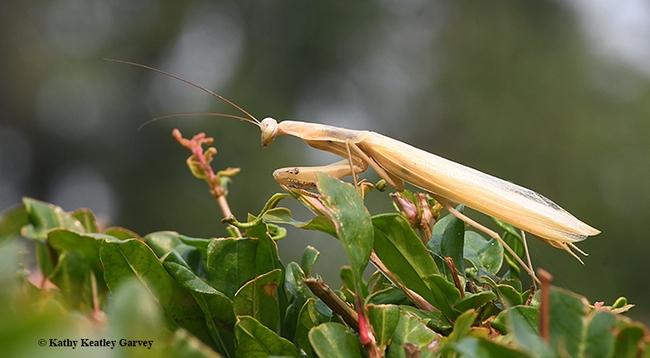
A male praying mantis, Mantis religiosa, emerges from a pomegranate bush. (Photo by Kathy Keatley Garvey)
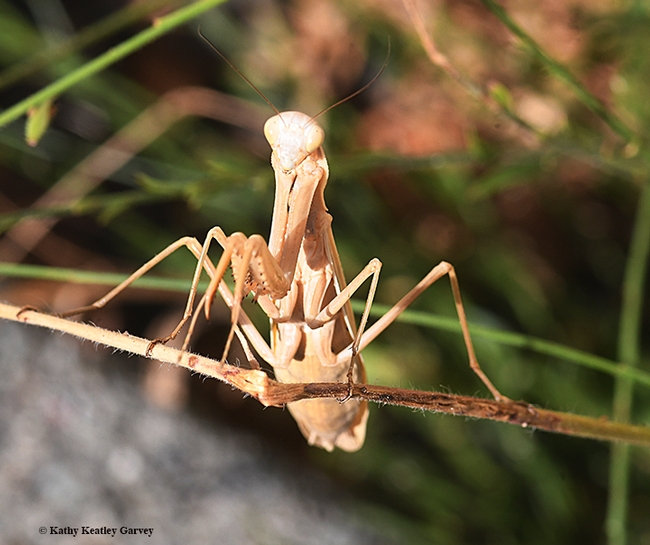
A female praying mantis, Mantis religiosa, strikes a pose. (Photo by Kathy Keatley Garvey)
Peruvian Daffodil
While walking through a local box store, I passed the rack where they had a few flower bulbs still left. So I rummaged through to see what they might have. That's when I found a bag of Peruvian Daffodils; the picture was interesting and since I did not know a thing about this bulb, I had to buy it and take it home.
Once I had it home I opened the bag and found 3 medium-size bulbs in it and very little information about them on the package. So to the Internet I went. What I found is that Peruvian Daffodil, Hymenocallis is not a true daffodil, but it does belong to the daffodil and amaryllis family.
When it did bloom it had a slight fragrance with white blossoms that looked like a large spider, in fact, its common name is “Spider Lily”.
They are a spring blooming plant, the soil should be kept moist not wet, so in the spring watering one a week should work. Fertilizer will encourage them to spread. If you are lucky enough to have several come up in the spring, after blooming and the leaves die back, they should be separated so they don't get overcrowded, otherwise, they will not bloom. They grow about 24 inches tall and can spread 6-12 inches wide. If you decided to dig them up in the fall, be sure to keep the bulbs where children and pets can't get to them as the bulbs are poisonous.
If they do propagate, next spring I hope to have more than the 3.
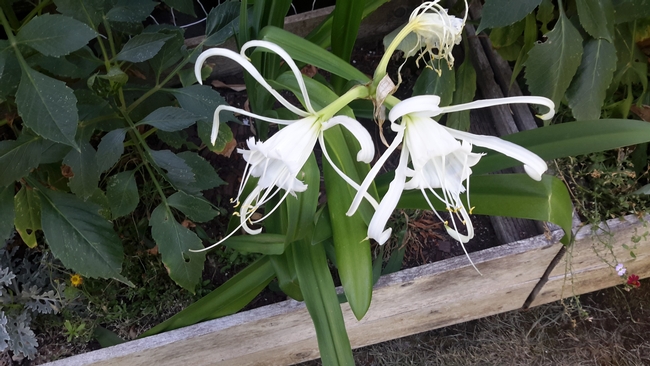
Peruvian Daffodil pic
Ladybug Assault
I had heard from many sources over the years that ladybugs can solve an aphid infestation. I have always had seasonal attacks but with a little water spraying, they were discouraged so it never seemed necessary to call in the big guns. In retrospect, I realize how modest my aphid numbers have been in the past. For some reason, this year was different. It was like a plague of biblical proportions. It must have had something to do with the jerky springtime and the microenvironment of my garden because my house blocks big wind coming from the front but not from the back. And it is the backyard that is under siege, especially the roses. Aphids don't seem to like many of the other flowering annuals I have in my garden.
My first thought, as usual, was to try a stiff shot of water. But I think the aphids took it as food. They were incredibly thick to the point that it was like a coating; as if I had painted the buds with these insects. Trying to stick to good IPM principles, I tried insecticidal soap. To no avail. I thought of getting more serious medicine after the little devils, but I was reluctant to use big guns, like insecticide. I dragged whatever I could get with my fingers, but as you can imagine that was of no long-term help. I was also beginning to worry about using too much water spraying since it looks like a dry summer may be our fate this year and I didn't want to contribute to water wastage for the vanity of having beautiful roses. I began to cut off the infested buds and stems, feeling like I was heading for a dismal summer.
As my despair turned to futility, I noticed a ladybug on one of the plants. Just how much could one bug consume, I thought. Within a couple of days, however, the ladybug visitation had grown considerably. At the height of the night-march of the ladybug cavalry, the plant had almost as may good bugs as bad. The bushes were literally weighed down with them – ceaselessly feasting on the aphids. I also bought a container of ladybugs packaged for this purpose. They joined in right away. It took barely a day of their voracious eating for me to be able to see the actual buds and stems again. After a couple of days, the major numbers of the good guys had moved off to another location but they did leave behind a small number of clean–up scouts to clear up the remaining bad bugs. But now the numbers were reduced enough that I could get them off with a good water spray. And I had renewed hope that the buds would open up.
The thing I learned the most from this whole encounter is the value of patience. I wasn't convinced that the good guys (or ladies, in this case) would win since they were so outnumbered. And also, once they started coming, the ladybugs swarmed in large numbers and stayed until their job was done. Nature is humbling.
Being relatively new to gardening, I had never witnessed nature taking care of itself so dramatically in my behalf. I was automatically reaching for a chemical solution and was really impressed by how the roses-aphids-ladybugs worked together at their own pace to fix the problem. I think that black spot will prove a tougher battle, but since there is really so little that I can do about it, I am trying patience to see how nature solves this one. My job seems to be to throw out the hopelessly damaged leaves and keep my fingers crossed.
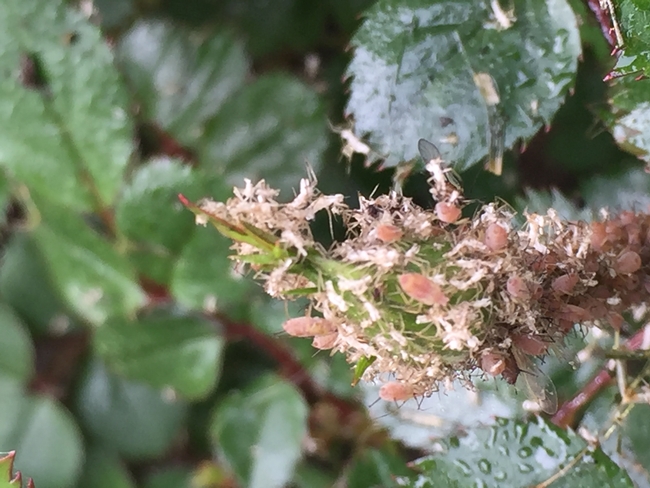
photos by Jennifer Baumbach
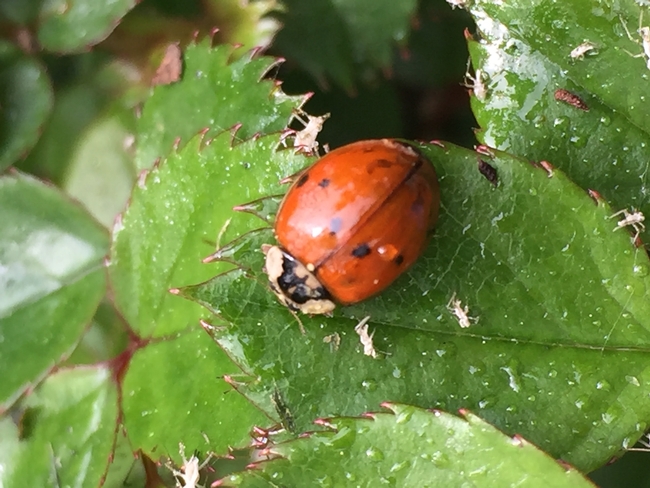
IMG 0067
About Those Declining Meadow Spittlebugs along the California Coastlne...
Who knew they were declining? Well, ecologists Richard "Rick" Karban Mikaela Huntzinger of the UC...
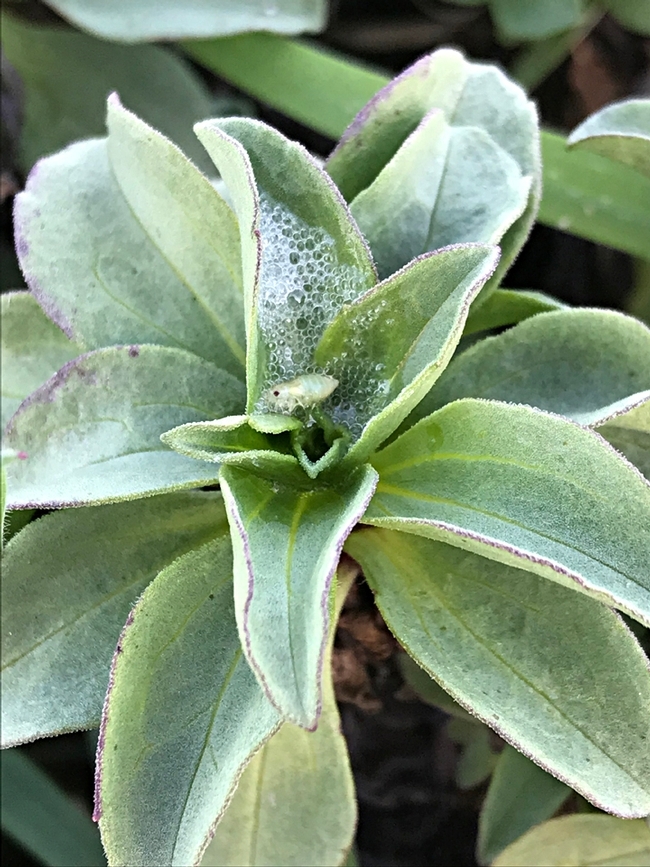
A meadow spittlebug nymph at the Bodega Marine Reserve. (Photo by Mikaela Huntzinger)

A graphic from the UC Davis researchers' article in the journal Ecology.



